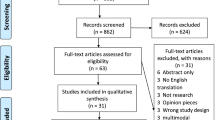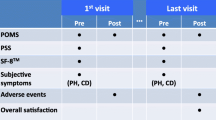Abstract
Purpose
The objective of this study was to investigate the effects of integrated yoga on the quality of life and interpersonal relationships in normal pregnant women.
Methods
One hundred and two pregnant women between 18 and 20 weeks of gestation who met the inclusion criteria were recruited from the obstetric units in Bangalore and were randomly assigned to two groups of yoga (n = 51) and control (n = 51). Women with medical conditions that could potentially lead to pregnancy complications and those with abnormal fetal parameters were excluded. The yoga group received integrated yoga while control group received standard antenatal exercises, both for 1-h three times a week from 20th to 36th week of gestation. Pre and post assessments were done using WHOQOL-100 and FIRO-B questionnaires.
Results
Of the six domains of WHOQOL-100, between groups analysis showed significant improvements in the yoga group compared to the control in the physical (P = 0.001), psychological (P < 0.001), social (P = 0.003), and environmental domains (P = 0.001). In FIRO-B, the yoga group showed significant improvements in ‘Expressed Inclusion’ (P = 0.02) and ‘Wanted Control’ (P = 0.009) domains compared to the control group.
Conclusion
The integrated yoga is an efficacious means of improving the quality of life of pregnant women and enhancing certain aspects of their interpersonal relationships.
Similar content being viewed by others
Abbreviations
- WHOQOL:
-
World Health Organization Quality of Life
- FIRO:
-
Fundamental Interpersonal Relationships Orientation
References
Larson, J. S. (2006). The World Health Organization’s definition of health: Social versus spiritual health. Social Indicators Research, 38, 181–192.
World Health Organization. (1948). Preamble to the constitution of the World Health Organization. Geneva: WHO.
Symon, A. (2003). A review of mothers’ prenatal and postnatal quality of life. Health Qual Life Outcomes, 1, 38.
Tamashiro, K. L., et al. (2007). Dynamic body weight and body composition changes in response to subordination stress. Physiology & Behavior, 91, 440–448.
Zahran, H. S., Kobau, R., Moriarty, D. G., Zack, M. M., Holt, J., & Donehoo, R. (2005). Health-related quality of life surveillance—United States, 1993–2002. MMWR Surveill Summ, 54, 1–35.
Gheorghe, C. P., Goyal, R., Mittal, A., & Longo, L. D. (2010). Gene expression in the placenta: Maternal stress and epigenetic responses. International Journal of Developmental Biology, 54, 507–523.
Cindrova-Davies, T. (2009). Gabor than award lecture 2008: Pre-eclampsia—from placental oxidative stress to maternal endothelial dysfunction. Placenta, 30(Suppl A), S55–S65.
Higgins, J. R., Walshe, J. J., Conroy, R. M., & Darling, M. R. (2002). The relation between maternal work, ambulatory blood pressure and pregnancy hypertension. Journal of Epidemiology and Community Health, 56, 389–393.
Marcoux, S., Brisson, J., & Fabia, J. (1989). The effect of leisure time physical activity on the risk of pre-eclampsia and gestational hypertension. Journal of Epidemiology and Community Health, 43, 147–152.
Coussons-Read, M. E., Okun, M. L., & Simms, B. S. (2003). The psychoneuroimmunology of pregnancy. Journal of Reproductive and Infant Psychology, 21, 103–112.
Weissgerber, T. L., Wolfe, L. A., & Davies, G. A. (2004). The role of regular physical activity in preeclampsia prevention. Medicine and Science in Sports and Exercise, 36, 2024–2031.
Armour, B., Pitts, M.M. & Walker, M.B. (2007) Maternal job stress and birth outcomes. Social Science Research Network Working Paper Series, 09–29.
Da Costa, D., Larouche, J., Dritsa, M., & Brender, W. (1999). Variations in stress levels over the course of pregnancy: Factors associated with elevated hassles state anxiety and pregnancy—specific stress. Journal of Psychosomatic Research, 47, 609–621.
Gjerdingen, D. K., Froberg, D. G., & Fontaine, P. (1991). The effects of social support on women’s health during pregnancy, labor and delivery and the postpartum period. Family Medicine, 23, 370–375.
House, J. S., Landis, K. R., & Umberson, D. (1988). Social relationships and health. Science, 241, 540–545.
Cohen, S. (2004). Social relationships and health. American Psychologist, 59, 676–684.
Parshad, O. (2004). Role of yoga in stress management. West Indian Medical Journal, 53, 191–194.
Michalsen, A., Grossman, P., Acil, A., Langhorst, J., Ludtke, R., Esch, T., et al. (2005). Rapid stress reduction and anxiolysis among distressed women as a consequence of a three-month intensive yoga program. Medical Science Monitor, 11, 555–561.
Berger, B. G., & Owen, D. R. (1988). Stress reduction and mood enhancement in four exercise modes: Swimming, body conditioning, hatha yoga and fencing. Research Quarterly for Exercise and Sport, 59(2), 148–159.
Oken, B. S., et al. (2006). Randomized, controlled six-month trial of yoga in healthy seniors: Effects on cognition and quality of life. Altern Ther Health Med, 12, 40–47.
Donesky-Cuenco, D., Nguyen, H. Q., Paul, S., & Carrieri-Kohlman, V. (2009). Yoga therapy decreases dyspnea-related distress and improves functional performance in people with chronic obstructive pulmonary disease: A pilot study. J Altern Complement Med, 15, 225–234.
Pullen, P. R., et al. (2008). Effects of yoga on inflammation and exercise capacity in patients with chronic heart failure. J Card Fail, 14, 407–413.
Moadel, A. B., et al. (2007). Randomized controlled trial of yoga among a multiethnic sample of breast cancer patients: Effects on quality of life. Journal of Clinical Oncology, 25, 4387–4395.
Skoro-Kondza, L., Tai, S. S., Gadelrab, R., Drincevic, D., & Greenhalgh, T. (2009). Community based yoga classes for type 2 diabetes: An exploratory randomised controlled trial. BMC Health Serv Res, 9, 33.
Badsha, H., Chhabra, V., Leibman, C., Mofti, A., & Kong, K. O. (2009). The benefits of yoga for rheumatoid arthritis: Results of a preliminary, structured 8-week program. Rheumatology International, 29(12), 1417–1421.
Mastrangelo, M. A., Galantino, M. L., & House, L. (2007). Effects of yoga on quality of life and flexibility in menopausal women: A case series. Explore (NY), 3, 42–45.
Duraiswamy, G., Thirthalli, J., Nagendra, H. R., & Gangadhar, B. N. (2007). Yoga therapy as an add-on treatment in the management of patients with schizophrenia—A randomized controlled trial. Acta Psychiatrica Scandinavica, 116, 226–232.
Nagendra, H. R., & Nagarathna, R. (1993). Therapeutic applications of an integrated approach of yoga therapy. Health Administrator, 4, 52–55.
WHOQOL Group. (1995). Field trial WHOQOL-100. February 1995: Facet definitions and questions. WHO: Geneva (MNH/PSF/95.1.B).
De Vire, J., & Van Heck, G. L. (1997). The World Health Organization Quality of Life assessment instrument (WHOQOL-100): Validation study with the Dutch version. European Journal of Psychological Assessment;, 13(3), 164–178.
Bonomi, A. E., Patrick, D. L., Bushnell, D. M., & Martin, M. (2000). Validation of the United States’ version of the World Health Organization Quality of Life (WHOQOL) instrument. Journal of Clinical Epidemiology, 53, 1–12.
Schutz, W. C. (1958). FIRO: A three dimensional theory of interpersonal behavior. New York, NY: Holt, Rinehart & Winston.
Ryan, L. R. (1977). Clinical interpretation of the FIRO-B. Palo Alto, CA: Consulting Psychologists.
Lundgren, T., Dahl, J., Yardi, N., & Melin, L. (2008). Acceptance and commitment therapy and yoga for drug-refractory epilepsy: A randomized controlled trial. Epilepsy & Behavior, 13, 102–108.
Lundgren, T., Dahl, J., Yardi, N., & Melin, L. (2008). Acceptance and commitment therapy and yoga for drug-refractory epilepsy: A randomized controlled trial. Epilepsy & Behavior, 13, 102–108.
Duraiswamy, G., Thirthalli, J., Nagendra, H. R., & Gangadhar, B. N. (2007). Yoga therapy as an add-on treatment in the management of patients with schizophrenia—A randomized controlled trial. Acta Psychiatrica Scandinavica, 116, 226–232.
Acknowledgments
We acknowledge with deep gratitude the efforts made by the staff members of Maiya Hospital and SVYASA University who facilitated this study. We particularly appreciate Dr. Ravi Kulkarni’s guidance during the data analysis and Mrs. Sushama Kirtikar’s assistance in proof reading the article. This project was institutionally funded by the SVYASA University of yogic sciences based in Bangalore, India.
Author information
Authors and Affiliations
Corresponding author
Rights and permissions
About this article
Cite this article
Rakhshani, A., Maharana, S., Raghuram, N. et al. Effects of integrated yoga on quality of life and interpersonal relationship of pregnant women. Qual Life Res 19, 1447–1455 (2010). https://doi.org/10.1007/s11136-010-9709-2
Accepted:
Published:
Issue Date:
DOI: https://doi.org/10.1007/s11136-010-9709-2




